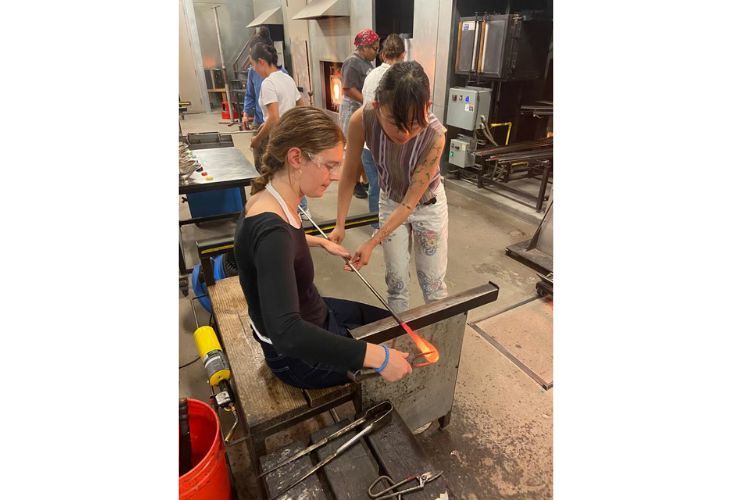On a sunny Saturday afternoon a few weeks ago, around half of Bard Graduate Center’s first-year MA class met at UrbanGlass in Brooklyn for a Materials Day workshop. We had spent the previous weeks learning and thinking about objects in historical and theoretical contexts in classes like Objects in Context and Approaches to the Object, where wearing safety glasses and non-synthetic fibers is not a requirement for participation.
Each semester BGC offers these Materials Days workshops to give students a tangible experience of making objects. At the start of the UrbanGlass workshop we were introduced to the tools we would be using by passing them around, getting a feel for them. The space was hot and we were encouraged to bring water and take breaks. I felt slightly over-caffeinated, and the thought of handling very hot glass was daunting. The orange-red inside of the glass furnace did not ease this feeling; the raw heat was as mesmerizing as it was painful to be near. But we worked in teams and were guided by an instructor through each step, and I became more comfortable and confident with time.
Hot glass needs to be handled quickly as it cools, and we could feel this as the glass became less malleable within seconds. Glassmaking, and many other forms of craft production, is very physical. The stakes of working with such a hot material force you to focus on the task at hand in almost a meditative sense.
The two objects we set out to make, with varying success, were a paper weight and a cup. Watching the demonstrations before and then actually trying to form the glass were two very separate experiences. Our instructors set out different colors and I spent a lot of time considering which color combination to use for my paperweight, and how it might look in my room.
One of the tools we used was a wooden plank, which we used to shield our partners from the heat of the glass. In class, we communicate ideas and thoughts, but here communication was quicker and more rudimentary, used to announce when you’re behind someone with a hot metal rod or to ask your partner to adjust how they are shielding you. My partner Mérida and I spent a lot of the time laughing at our mangled creations and talking about how the process felt. There was no expectation to create something beautiful or even functional; we were just figuring out how to handle and shape glass. This is not unlike how I view my first semester at Bard Graduate Center as we establish an intellectual foundation for the rest of our time here.
We were able to pick up our pieces a few days after the workshop and unwrapping them was as delightful as making them. They had cooled and hardened, and were now ours to keep. As an academic exercise, this workshop gave me a tangible understanding of the process of glassmaking. Not only do I now know how a glass furnace looks, I know how the heat feels.
By Sarah Egan (MA ’26)




